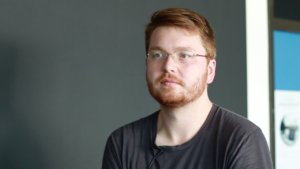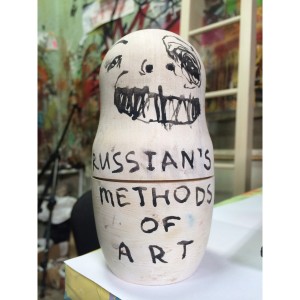Z: Assuming there really is a resilient idea, from our point of view resilient. Then it has to be visualized. First in 2D, so there are either photos that you can try to work with or an entire 3D environment in which our object appears in 3D. That usually goes along with a model in a different scale to test and present the physical capacity of the project in the sense of: What does it look like, what does it feel like? What kind of surface, colour or whatever does it have? To test it and also to present it. And very important is a text, not more than one page, which describes our idea behind everything in a compact kind of way. Then there are a whole lot of plans. So those are all demands on us. There are cuts, there are construction plans, there are all kinds of things. Another five to ten pages. Then there is also something like a time line: How long does it take to actually produce it? And one page where it says how expensive it will be.
Z: Vorausgesetzt es gibt tatsächlich eine, in unserer Vorstellungen, belastbare Idee, dann geht es darum das zu visualisieren. Einmal in 2D, das heißt entweder gibt es Fotos, in die das in irgendeine Art und Weise herangearbeitet wird oder es wird ein komplettes 3D-Environment geschaffen, wo dann unser Objekt in 3D auftaucht. Dazu gibt es dann fast immer auch ein Modell in einem unterschiedlichen Maßstab, um quasi die physische Belastbarkeit des Projektes im Sinne von: Wie sieht denn das aus, wie fasst sich das an? Was hat das für eine Oberfläche, was für eine Farbe oder Ähnliches, zu testen und dann auch zu präsentieren. Ganz wichtig, es gibt einen Text, der nicht länger als eine DIN A4 Seite ist, der aber relativ kondensiert das textlich darstellen soll, was unsere Idee im weitesten Sinne dazu ist. Dann gibt es eine ganze Reihe von Plänen. Das sind also alles Anforderungen, die an uns gestellt werden. Also es gibt Schnitte, es gibt Konstruktionspläne, es gibt alles Mögliche. Ungefähr nochmal fünf oder zehn Seiten. Dann gibt es noch so etwas wie eine Timeline: Wie lange dauert das ungefähr bis wir das dann tatsächlich produziert haben könnten? Und ein Blatt wo drauf steht wie teuer es ist.
H: We are also always on-site for so called colloquia in advance of the brainstorming, just to get to know the location. To have realistically encountered all parameters and then think about it. And when the work is finished, there is also always one of us there to present, to somehow open it. To answer the journalists’ questions and to bring the whole thing to an end somehow.
H: Also wir sind auch immer vor Ort für sogenannte Kolloquien im Vorfeld der Ideenfindung, um den Ort zu sehen. Um alle Parameter real erfahren zu haben und dann nachdenken zu können. Und wenn die Arbeit fertig ist, ist auch immer jemand von uns da, um das zu eröffnen sozusagen. Und Journalisten Rede und Antwort zu stehen und das Ganze irgendwie dann letztendlich abzuschließen.
Z: We just realized two things. Just opened last week in Canada, Calgary. And we are currently working on two further competitions for a prison in Stuttgart – Stammheim.
Z: Wir haben gerade zwei Sachen realisiert. Fertig eröffnet letzte Woche in Kanada – Calgary. Und arbeiten an zwei weiteren Wettbewerben zur Justizvollzugsanstalt Stuttgart – Stammheim.
H: And for the Science Center or City in Newcastle in England: a project where the city of Newcastle wants to rebuild an inner-city area. An area where there used to be a huge brewery. They want to build a Science City on that spot in cooperation with the University of Newcastle and economic companies, they want to do research there. The University is known for its specific research, especially in the field of sustainability. It’s about gerontology, about …
H: Und zur Science City in New Castle in England. Ein Projekt wo die Stadt Newcastle in innerstädtisches Gebiet neu bebauen will. Ein Gebiet auf dem früher eine ganz große Brauerei stand. Die wollen jetzt dort eine Science City bauen in Verbindung mit der Universität Newcastle und wirtschaftlichen Unternehmen. Die Universität ist ja bekannt für spezielle Forschung, vor allem im Bereich sustainability, also Nachhaltigkeit. Und da geht es um Altersforschung, um…
Z: …mobility, all sorts of things.
Z: Mobilität, alles mögliche…
H: Yes. Everything you can imagine. Urban Sustainability is the theme. There are dozens of houses supposed to be built in this area. Next year the first house will be built and in front of it there is a central square. Close to where the historic city center is they want the sculpture. Explicitly. They invited 4 artists for that, three from England and us. Now this is a special project because we had actually already won the competition last year. Our draft was chosen and we had already developed it further. Also concerning the possibilities of how to produce it. And then there happened kind of a mishap. The vice president of the University of Newcastle, who is the boss, got to know very late, what was to be done there and then suddenly saw it in a phase, when all other juries had already approved it and then laid in his veto.
H: Ja. Alles was man sich so vorstellen kann. Urban Sustainability ist das Thema. Und dort, auf diesem Neubaugebiet sollen also zig Häuser entstehen. Da entsteht jetzt nächstes Jahr das erste Gebäude und davor gibt es einen zentralen Platz zur alten Stadt hingelagert und dort wollen die auch eine Skulptur, explizit und haben dafür vier Künstler eingeladen. Drei aus England und uns. Und das ist jetzt ein spezielles Projekt, denn wir hatten den Wettbewerb eigentlich schon gewonnen letztes Jahr. Unser Entwurf wurde ausgewählt. Wir hatten den sogar schon sehr weit entwickelt, also auch in der Möglichkeit ihn zu produzieren. Und dann ist da sozusagen eine Art Malheur passiert. Der Vizepräsident der Universität Newcastle, der ja dort der Chef ist, der hat das sehr spät erfahren was dort gemacht werden soll, hat das dann plötzlich gesehen in der Phase wo es eigentlich schon von allen Jurien abgesegnet war und hat da sein Veto eingelegt.
Z: Exactly.
Z: Genau.
H: Now we once more want to…
H: Jetzt wollten wir noch mal…
Z: It’s a new-feudalism thought to just do it that way because usually these processes are somewhat democratic. But oh well, that’s the way it is.
Z: Neofeudalistischer Gedanke das einfach so zu machen, weil üblicherweise sind diese Prozesse schon ein bisschen demokratisiert. Aber naja so ist es halt.
H: Something like that has never happened to us before. Anyway, everything was stopped but we were hired again to exclusively hand in two other proposals again. Usually it works like that: a jury makes a decision on one of the proposals and then makes recommendations on how to realize it and that’s usually how it is done. But it has happened to us a few times that it won’t be realized at all. Budgets are cut for some reasons. It is similar to what architects face. There I think it happens quite a lot. Well, those are the two things we are currently working on: Stammheim and Newcastle.
H: So etwas ist und auch noch nicht passiert. Auf jeden Fall alles gestoppt und jetzt wurden wir aber noch mal beauftragt exklusiv noch mal zwei Vorschläge zu machen.
Also es ist ja so, dass sich eine Jury für einen Vorschlag entscheidet und spricht dann Empfehlungen aus das zu realisieren und in der Regel wird das gemacht, aber es ist uns auch schon ein paar Mal passiert, dass das nicht überhaupt nicht realisiert wird. Dass plötzlich die Etats gestrichen werden aus irgendwelchen Gründen. Das ist ähnliche wie bei Architekten. Das passiert da glaube auch öfter. Genau, das die zwei Sachen, an denen wir jetzt aktuell arbeiten. Stammheim und Newcastle.

















